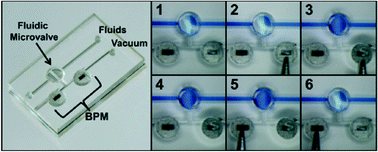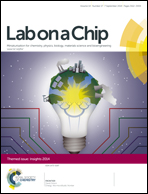Manually operatable on-chip bistable pneumatic microstructures for microfluidic manipulations†
Abstract
Bistable microvalves are of particular interest because of their distinct nature of requiring energy consumption only during the transition between the open and closed states. This characteristic can be highly advantageous in reducing the number of external inputs and the complexity of control circuitries since microfluidic devices as contemporary lab-on-a-chip platforms are transferring from research settings to low-resource environments with high integrability and a small form factor. In this paper, we first present manually operatable, on-chip bistable pneumatic microstructures (BPMs) for microfluidic manipulation. The structural design and operation of the BPM devices can be readily integrated into any pneumatically powered microfluidic network consisting of pneumatic and fluidic channels. It is mainly composed of a vacuum activation chamber (VAC) and a pressure release chamber (PRC), of which users have direct control through finger pressing to switch either to the bistable vacuum state (VS) or the atmospheric state (AS). We have integrated multiple BPM devices into a 4-to-1 microfluidic multiplexor to demonstrate on-chip digital flow switching from different sources. Furthermore, we have shown its clinical relevance in a point-of-care diagnostic chip that processes blood samples to identify the distinct blood types (A/B/O) on-chip.


 Please wait while we load your content...
Please wait while we load your content...